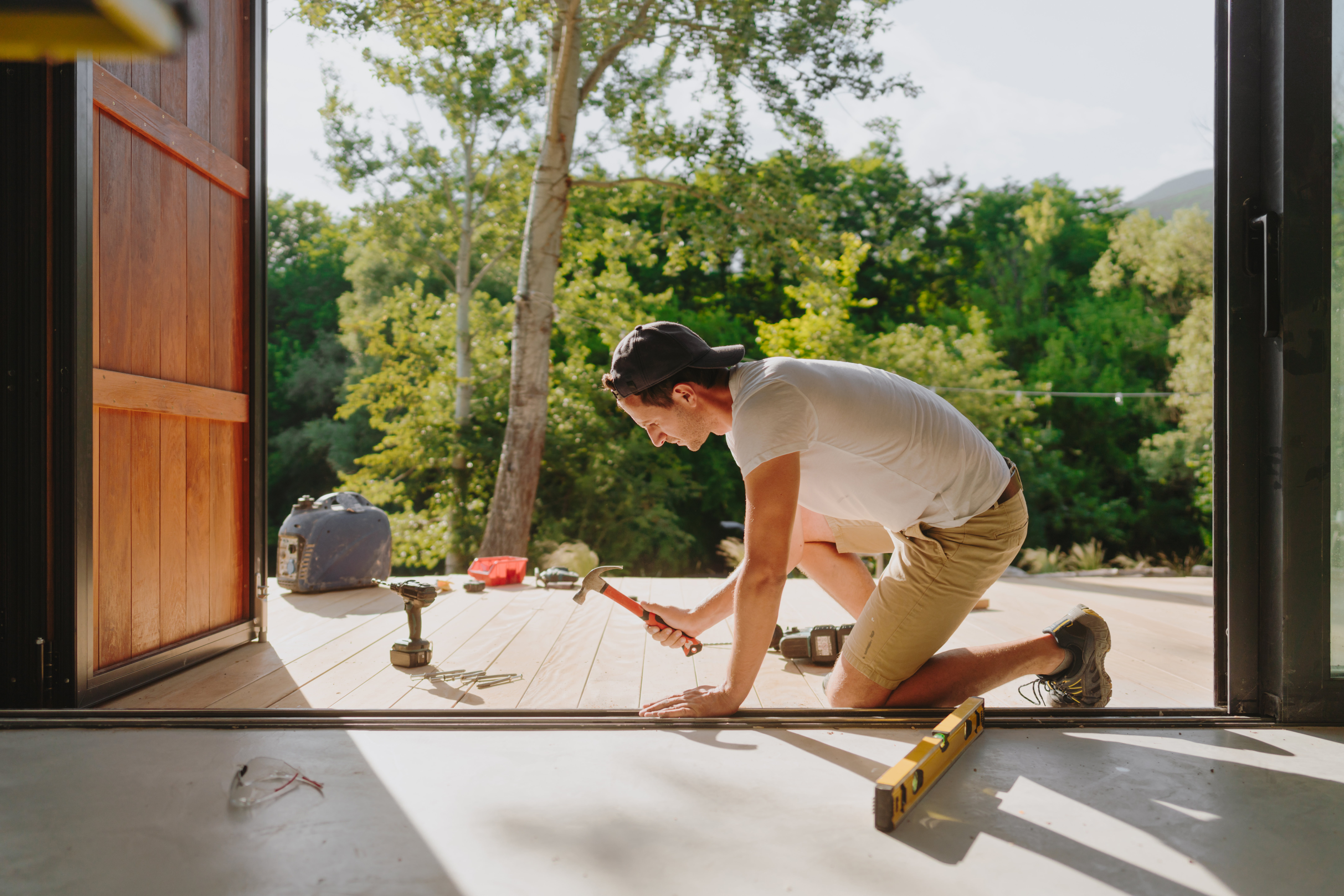FHA 203(k) rehab loan explained
_rehab_loan_explained.jpg)
Are you looking to buy a fixer-upper or breathe new life into your current home but concerned about financing the renovations? An FHA 203(k) loan might be the solution you’ve been looking for. This renovation loan program offers a streamlined way to combine your home purchase or refinance with renovation costs, simplifying the process.
In this article, we’ll break down the different FHA 203(k) loan options so you can confidently choose the best option for your situation. Plus, we’ll explain how this renovation loan can simplify the renovation process and save you money over time.
If you’re ready to begin, complete our Digital Mortgage and see how you can get pre-approved in minutes.
What Is a 203k FHA Loan?
An FHA 203(k) loan helps homeowners and homebuyers combine the costs of buying or refinancing a home. It also includes the expenses for needed repairs or renovations. Compared to conventional loans, this loan's backing by the Federal Housing Administration makes it easier to qualify. It covers not only the purchase price of the home but also the renovation costs.
This loan is particularly helpful for those buying a fixer-upper that may not meet standard real estate mortgage qualifications due to its condition.
Mortgage lenders are often hesitant to approve loans for homes needing major repairs. However, the FHA 203(k) loan provides them with security by ensuring that repairs, as specified in an FHA appraisal, will be completed to eliminate safety hazards.
How Does An FHA 203(k) Loan Work?
The process of getting an FHA 203(k) loan involves several steps.
Steps to Getting an FHA 203 (k) Loan
Step 1: Meet Minimum Eligibility Requirements
First, borrowers must meet eligibility requirements, such as a minimum credit score of 620 and a debt-to-income ratio below 43%.
The loan amount depends on the property’s condition and renovation plans but must remain within the FHA loan limits set by the U.S. Department of Housing and Urban Development.
The home must also be your primary residence, meaning you intend to move in after the renovation.
Step 2: Selecting the Right Property
After confirming eligibility, you’ll choose a property that needs renovations and create a detailed renovation plan, including cost estimates for structural repairs.
Step 3: Apply through an FHA-Approved Mortgage Lender
Next, apply for the loan through an FHA-approved mortgage lender such as Rate. Submit income proof, tax returns, and renovation details. You can verify your lender's credentials using NMLS Consumer Access, a free service that confirms a lender’s licensing.
For larger projects, the Standard 203(k) loan requires a HUD-approved consultant to evaluate the renovation plan, conduct an appraisal, and ensure the improvements will add value to the home.
For smaller projects, the Limited (Streamline) 203(k) loan doesn’t require a consultant, but it’s important to work with a trusted contractor. During renovations, funds are held in an escrow account and released as work progresses. For complex repairs, funds are disbursed in stages.
Step 4: Closing Requirements
Once the loan is approved and closed, work must begin within 30 days. All renovations should be completed within six months, with contractors receiving payments as major milestones are reached. Streamlined projects usually involve an initial and final payment to contractors.
What You Should Know About Interest Rates for FHA 203K Loans
Interest rates for FHA 203(k) loans vary depending on the lender and current market conditions.
Generally, they are slightly higher than standard FHA loans because of the added risk associated with renovation projects.
You should shop around and compare rates from multiple FHA-approved lenders, like Rate, to find the most favorable terms.
What Are the Different Types of FHA 203(k) Loans?
There are two types of FHA 203(k) loans: the Standard 203(k) Loan and the Limited (Streamline) 203(k) Loan. Each option is suited for different types of renovation projects based on the scope of repairs and costs involved.
Streamline (Limited) FHA 203(k) Loan
The Streamline 203(k) Loan is designed for smaller, non-structural repairs. Borrowers can finance up to $75,000 in renovations.
With typically lower mortgage rates than unsecured home improvement loans, the Limited 203(k) Loan offers manageable payments and substantial savings.
There is no minimum repair cost. This makes it easy for homeowners to update their homes without big renovations. However, it doesn’t cover structural changes or significant remodeling.
Standard FHA 203(k) Loan
The Standard 203(k) Loan, also called the Full 203(k), is for larger projects involving structural repairs or renovations exceeding $75,000.
Unlike the Streamline version, the Standard loan has a minimum repair cost of $5,000.
A HUD-approved consultant must oversee the renovation plan to ensure it meets loan officer and FHA guidelines. The loan amount can be higher depending on the property’s value and underwriting requirements.
What Can an FHA 203(k) Loan Be Used For?
With an FHA 203(k) loan, you can:
- Repair the roof, including gutters and downspouts.
- Upgrade or install energy efficient HVAC systems.
- Fix health and safety hazards, such as faulty wiring or structural issues.
- Enhance accessibility, making the home more functional for disabled persons.
- Repair septic systems.
- Modernize the home with new finishes, including painting, updated kitchens, and bathroom remodels.
- Convert a single-family home into a multi-unit property, or vice versa.
Use an FHA 203(K) Loan to Refinance Your Current Mortgage and Fund Renovations
The FHA 203(k) loan can be used to refinance your existing mortgage and fund renovations. This allows you to combine both your current mortgage and renovation costs into a single loan, simplifying your finances with just one monthly payment to manage.
What Are the Limitations on FHA 203K?
Luxury amenities—such as swimming pools, tennis courts, or outdoor kitchens—are not covered. Similarly, minor landscaping projects or anything considered non-essential to the home’s function will not be eligible.
Can You Do the Renovations Yourself With an FHA 203(K) Loan?
While DIY renovations are allowed under certain conditions, you must prove you’re qualified to complete the work yourself.
However, funds cannot be used to pay for your labor. Most borrowers prefer hiring licensed contractors to ensure the work meets FHA guidelines and deadlines.
Conventional Home Rehab Loans Vs. FHA 203(k) Loans
Here’s how conventional home improvement loans differ from FHA 203(k) loans:
Credit Requirements and Down Payments
One key difference is the down payment requirements.
Conventional construction loans tend to have stricter requirements, including higher credit scores requirements and lower debt-to-income ratios. Additionally, borrowers are often required to pay higher origination fees and make larger down payments of around 20% to avoid private mortgage insurance (PMI).
In contrast, FHA mortgage loans, including the 203(k), are more accessible to borrowers with lower credit scores and higher debt-to-income ratios. With down payment options as low as 3.5%, FHA loans are particularly appealing to first-time homebuyers or those with limited funds for a down payment.
However, FHA loans require both upfront and annual mortgage insurance premiums (MIP), which remain in place for the life of the loan unless refinanced.
Loan Limits and Property Types
Higher loan limits are frequently available with conventional rehab loans, which depend on the borrower's qualifications and the lender's discretion.
This makes them a better choice for larger or more expensive renovation projects. They also offer financing for a variety of property types, including mixed-use properties and residential homes.
On the other hand, FHA 203(k) loans are subject to county-specific loan limits, which may not be sufficient for more extensive or luxury renovations. Additionally, FHA loans can only be used for single-family homes or one-to-four-unit properties that are at least a year old, limiting the types of properties eligible for this loan.
Can You Recast an FHA Loan?
FHA loans, including the 203(k), generally do not offer the option to recast, which allows borrowers to reduce their monthly payments after making a large lump-sum payment toward the loan.
If you’re looking for lower payments, you might want to explore refinancing options instead.
Insurance Considerations
For borrowers using conventional home rehab loans, private mortgage insurance (PMI) is typically required if the down payment is less than 20%. Fortunately, PMI can be removed once the homeowner has built up sufficient equity in the home.
However, with FHA 203(k) loans, borrowers must pay both an upfront mortgage insurance premium (MIP) and an annual premium. MIP is required for the entire life of the loan unless the borrower refinances into a conventional mortgage once they have built enough equity.
How Long Does the FHA 203(K) Loan Process Take?
Due to the additional steps involved in planning and approving renovations, the FHA 203(k) loan process can take longer than traditional mortgages.
On average, it may take 60 to 90 days from application to closing. The complexity of the renovations and the speed of submitting plans can affect the timeline.
Start the FHA 203(k) Loan Process
Ready to finance your home renovation? At Rate, we’re ready to guide you through this journey. Whether you’re financing through a fixed-rate or adjustable-rate mortgage, complete our Digital Mortgage application to get pre-approved today.
Our experts can also help explain the differences between an FHA mortgage and a conventional loan, and guide you through closing costs.
Credit score and down payment requirements higher for 2-4 unit, investment properties and renovation products.
Rate, Inc is a private corporation organized under the laws of the State of Delaware. It has no affiliation with the US Department of Housing and Urban Development, the US Department of Veterans Affairs, the Nevada Department of Veterans Services, the US Department of Agriculture, or any other government agency. No compensation can be received for advising or assisting another person with a matter relating to veterans’ benefits except as authorized under Title 38 of the United States Code.




